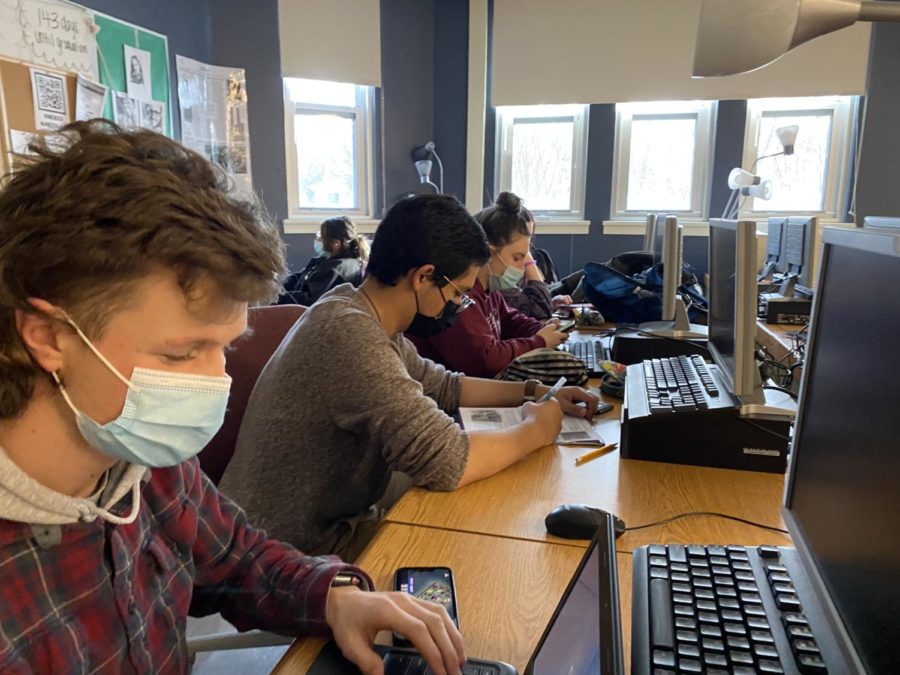The Omicron variant does not warrant school closures
Students grades and mental health would suffer if we returned to remote learning.
January 6, 2022
As students and teachers have returned from Winter Break, the halls and classrooms of Riverside-Brookfield high school have been filled with worried whispers of a return to remote learning. This great worry comes in the face of the recent surge in COVID-19 cases spurred on by the Omicron variant. RB’s administration has continually asserted their dedication to keep the students body in the building, while also prioritizing their safety. I believe that anything other than in-person, full attendance school from 8 AM- 3:05 each day would be a great disservice to students, and a decision leading to remote learning would be influenced by unwarranted fear rather than a careful examination of the risks at hand.
I truly don’t believe that we will transition to remote learning at any point this semester, but the sheer amount of my peers who have expressed their worries, or even wishes for this to happen has prompted me to write this article.
Omicron cases are spreading quite rapidly, no one can deny that, since the beginning of December RB’s COVID-19 dashboard has reported 128 COVID cases amongst students and 31 among teachers. Contrary to many in the school community, this jump in cases does not worry me in the slightest, in fact it gives me hope for the end of the Pandemic. There’s no way for me to find this information on the website, but I’m willing to wager that very few, if any of these cases have resulted in hospitalization. There is still much to learn about Omicron, but everything we know thus far indicates that it is more transmissible, yes, but far less severe than previous variants such as Delta and Alpha. A study conducted in Ontario, Canada and later cited by Dr. Anthony Fauci found that risk of hospitalization was 65% lower among those infected with Omicron, while risk of admission to an intensive care unit or death was 83% lower. This data speaks for itself, the Omicron variant is not nearly as worrying as past strains of COVID, and shutting down school for fear of rising infections would be rash, irresponsible and unwise.
When considering how Omicron should affect schools, the importance of population demographics cannot be understated. RB’s population, as well as that of any other high school in that world, consists of mostly 14-18 year olds, of whom, 76.6% are vaccinated against COVID. Study upon study has shown that COVID is less severe for young people, and obviously vaccinations provide great protection against the virus. CNN medical analyst Dr. Leana Wen went as far as to say it is “crucial” for schools to continue practicing in-person instruction, citing protections offered by vaccines and the fact that schools have been documented as “very safe” from a COVID-19 standpoint. Wen’s latter point is the one which I take particular interest in. I believe that most of my peers hold a false belief that schools are an environment inherently susceptible to a rampant spread of COVID cases, this assumption does not hold true. Another CNN analyst, Dr. Sanjay Gupta ranked the places where he believes individuals are most likely to catch COVID, his list included places of worship, hotels, bars/restaurants and cafes, but not schools. High vaccination rates, especially at RB, a generally low-risk population and implementation of safety measures combine to make schools about the safest crowded place you can be in during the time of a pandemic.
While many considerations must be taken into account, I’ll only discuss one more, the one which I view to be most important. Virtually all data has shown that anything other than fully in-person school directly leads to declining grades and mental health amongst students. During last year’s third quarter, 17% of RB students failed a class, for the majority of this time the school was following a hybrid learning plan which saw only 25% of students attend in-person school 4 days a week from 8 AM to 12:35 PM. That 17% of students received a grand total of 596 F’s during third quarter, for reference, 418 failing grades were handed out during third quarter in 2020 (part of which was remote), while just 385 were awarded during 2019’s third quarter. This data demonstrates an incredibly troubling trend, one that is clearly exacerbated by remote learning. This increase in failed grades may be closely associated with an increase in mental health issues demonstrated in students nationwide, and likely represented at RB as well. According to Pew Research Center, emergency department visits for suspected suicide attempts among adolescents jumped 31% in 2020, while visits in that same category were 51% higher in March and February of 2021 among girls between ages 12 and 17 compared to the same time period in 2019. A trend so strong nationwide such as this one cannot be ignored at the local level, these issues have very likely affected RB students. This increase is also very clearly not a coincidence, while impacted by the pandemic in general, they must be due in large part to isolation brought on by remote learning.
COVID cases are no doubt surging, this should not be taken lightly whatsoever, and I would be open to increased precautions such as an alternate lunchroom, or greater enforcement of mask-wearing. However, I believe that at this moment students need to be in school, in-person above all else. A switch to remote learning would be an immense disservice to RB’s students, and would truly accomplish nothing meaningful at best, while exasperating already heightened mental health problems at worst.



